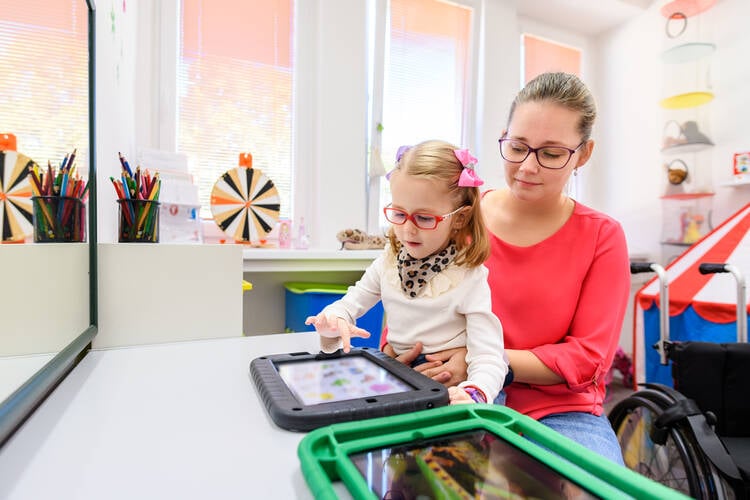
Non-verbal ABA therapy activities are activities designed to teach and reinforce skills without relying on spoken language.
These activities focus on gestures, facial expressions, body movements, picture cues, and other forms of non-verbal communication.
They are ideal for clients who are non-speaking, minimally verbal, or developing early communication skills, providing alternative ways to express needs, emotions, and responses while building the foundation for future verbal language development.
If you own an ABA therapy business and want to better serve a diverse range of clients, incorporating non-verbal ABA therapy activities can be highly beneficial.
These activities can improve social interaction, receptive communication, emotional understanding, and functional skills.
In this article, we will share some of the best non-verbal ABA therapy activities you can integrate into your sessions to create a supportive, inclusive, and engaging learning environment for all your clients.
Best Non-Verbal ABA Therapy Activities
-
Picture Exchange Communication System (PECS)
Picture Exchange Communication System (PECS) teaches children to communicate using pictures instead of spoken words.
Start by introducing a few highly motivating pictures, such as snacks or favorite toys, and model how to hand the picture to request the item.
Picture Exchange Communication System (PECS) helps build functional communication skills, reduces frustration, and promotes independence.
Over time, children can progress to forming simple picture sentences. This activity is ideal for children who are non-verbal or minimally verbal and works well in both therapy sessions and home environments.
-
Gesture-Based Communication
This activity focuses on teaching children to use gestures, such as pointing, waving, or nodding, to communicate.
Start with simple, meaningful gestures tied to daily needs, like pointing to a preferred item or waving “bye-bye.”
Model the gesture, physically prompt if needed, and reinforce successful use.
Gesture-based communication supports non-verbal expression, social interaction, and the development of joint attention skills.
It’s especially useful as a bridge to verbal communication or alternative systems like sign language.
-
Sign Language Basics
Introducing basic sign language offers children an alternative method of communication. Begin with simple, high-use signs such as “more,” “eat,” “drink,” and “help.”
Pair each sign with the actual item or activity to strengthen the association.
Model the sign, guide the child’s hands if necessary, and reinforce every successful attempt.
Sign language can reduce frustration, encourage interaction, and improve comprehension.
It also empowers children to express needs and feelings effectively while building a foundation for more complex language development.
-
Imitating Actions with Objects
In this activity, children learn to copy modeled actions using toys or tools. Examples include rolling a toy car, stacking blocks, or stirring with a spoon.
Demonstrate the action, then prompt the child to imitate it. Reinforce correct imitation immediately.
This skill supports fine and gross motor development, attention to detail, and symbolic play.
Action imitation is also foundational for developing more complex play and daily living skills.
Using preferred objects increases motivation, and rotating items keeps the activity engaging while encouraging flexibility in learning.
-
Matching Objects
This activity focuses on helping children develop visual discrimination and categorization skills by having them match identical objects.
Begin with a small set of two or three items, such as blocks or cups, and prompt the child to pair them correctly.
Gradually increase both the number and variety of objects to introduce more challenge.
Reinforce successful matches with praise or small rewards to encourage participation.
Matching objects builds a foundation for sorting, problem-solving, and early academic skills, and can be adapted with different textures, shapes, or colors to engage multiple developmental areas.
-
Matching Pictures
This activity helps children develop visual discrimination and cognitive skills by having them match identical or related pictures, such as two images of a dog or a cup and saucer.
Use laminated picture cards for durability and easy handling. Start with familiar images to build confidence, then gradually introduce new objects or concepts to expand learning.
Matching pictures enhances visual memory, attention to detail, and pre-reading abilities by fostering an understanding of symbols.
Increasing complexity, such as pairing photos with illustrations, promotes flexibility and generalization across different contexts.
-
Sorting by Color
This activity teaches children to categorize objects based on color, beginning with basic colors like red, blue, and yellow.
Provide a variety of items, such as blocks, buttons, or balls, and demonstrate how to sort them into corresponding containers.
Encourage the child to attempt sorting independently, offering reinforcement for correct placements.
Gradually introduce additional colors to increase the challenge. Sorting by color enhances visual discrimination, organizational skills, and early math readiness.
The activity can be adapted with seasonal items, themed objects, or varying materials to maintain engagement and motivation.
-
Sensory Play Activities
Sensory play engages non-verbal learners by using a variety of textures, sounds, and visual stimuli to encourage exploration and learning.
Activities can include playing with kinetic sand, water beads, textured fabrics, or other tactile materials.
Sensory bins can be themed to align with seasonal topics or educational goals, making sessions both fun and purposeful.
This type of play supports self-regulation, fine motor development, and cognitive skills.
Structured sessions with careful monitoring prevent overstimulation, while also providing opportunities for social interaction and communication without relying on verbal language.
-
Emotion Matching
This activity helps children identify and understand emotions by matching pictures of faces that display the same feeling.
Begin with simple, easily recognizable emotions such as happy, sad, and angry, then gradually introduce more complex feelings like surprised, frustrated, or confused.
Use a variety of visual aids, including real photographs, illustrations, or emojis, to maintain engagement.
Reinforce correct matches with praise or small rewards, and encourage the child to mimic the emotion as an added practice.
-
Following Non-Verbal Cues
This activity focuses on helping children understand and respond to non-verbal cues such as gestures, facial expressions, and body language.
For example, a pointing gesture can indicate where to go, while a hand wave can signal “stop.”
Begin by clearly modeling each cue and guiding the child to respond appropriately, providing immediate reinforcement for correct actions.
Practicing the recognition and response to non-verbal signals enhances receptive communication, attention, and social awareness.
-
Puzzle Assembly
Puzzles are an excellent non-verbal activity for developing problem-solving abilities, visual-spatial skills, and fine motor coordination.
Begin with simple, large-piece puzzles featuring clear, familiar images, then gradually introduce more complex puzzles as the child’s skills improve.
Model how to place a piece correctly, then allow the child to try independently, offering hand-over-hand assistance when needed.
Reinforce each successful placement with praise or small rewards. Engaging with puzzles encourages persistence, concentration, and independent play.
-
Object Requesting Without Words
This activity focuses on teaching children to communicate non-verbally by requesting desired items through gestures such as pointing, reaching, or handing over a corresponding picture or symbol.
Start with highly motivating items to capture attention and encourage participation.
Model the correct behavior, provide prompts as needed, and reinforce successful attempts immediately to strengthen learning.
Developing this skill helps reduce frustration, increases independence, and empowers children to express their needs effectively.
It also lays the groundwork for advancing to structured communication systems like PECS or basic sign language.
-
Role-Play with Props
Non-verbal role-play activities use props such as hats, toy tools, or kitchen items to create engaging scenarios without requiring verbal instructions.
Begin by modeling simple actions like pretending to cook, sweep, or fix something, then prompt the child to imitate each step.
Reinforce successful attempts and gradually introduce more complex sequences.
Role-play encourages symbolic thinking, creativity, and problem-solving, while also developing social understanding and imitation skills.
These activities help children practice real-world tasks, navigate social interactions, and build confidence in a fun, hands-on way.
-
Non-Verbal Turn-Taking Games
Non-verbal turn-taking games, such as rolling a ball back and forth, stacking blocks alternately, or passing an object, provide children with opportunities to practice cooperative play without relying on speech.
Use clear physical cues like offering the object, tapping it gently, or making eye contact to indicate whose turn it is.
These structured activities help children develop patience, understand the concept of waiting, and improve joint attention skills.
Practicing turn-taking in this way fosters positive social behavior, encourages interaction, and builds foundational skills for group activities and teamwork.
-
Copying Facial Expressions
This activity focuses on teaching children to recognize and imitate facial expressions, an essential component of non-verbal communication.
Begin by modeling simple expressions such as smiling, frowning, or raising eyebrows, and encourage the child to copy each one.
Provide immediate reinforcement for correct attempts, gradually introducing a wider range of emotions and subtle variations to build flexibility.
Practicing facial expressions helps children develop emotional recognition, improve social awareness, and strengthen imitation skills.
